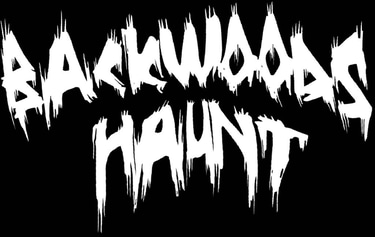
Films That Influenced Our Scenes
Discover how classic horror films inspired the terrifying scenes at Backwoods Haunt
7/19/20254 min read


Horror Movie Inspirations: Films That Influenced Our Scenes
Every great haunted house starts with great inspiration, and at Backwoods Haunt, we've drawn from some of the most bone-chilling films ever made. These movies didn't just scare us – they taught us what it feels like and how to recreate that visceral fear in a live experience.
Here's a behind-the-scenes look at the films that shaped our nightmares and how they've influenced the terror waiting for you in our woods.
Wrong Turn (2003): When the Woods Fight Back
The Inspiration Wrong Turn taught us that sometimes the most terrifying monsters are the ones that could actually exist. The film's isolated mountain setting and the feeling of being hunted by something that knows the terrain better than you do became foundational to our backwoods concept.
How We Applied It Our "Lost in the Woods" section draws heavily from this film's atmosphere of disorientation and pursuit. We've created winding paths that make visitors feel genuinely lost, with our actors positioned to take advantage of every blind corner and dense patch of trees.
The key element we borrowed isn't just the jump scares – it's the building tension of knowing you're being watched. Our guests often report feeling eyes on them long before they see our woodland creatures, and that's exactly the effect we were going for.
Our Backwoods Touch While Wrong Turn focused on cannibalistic mountain men, we've expanded the concept to include various backwoods dwellers who've made these woods their hunting ground. Each has their own territory and hunting style, keeping guests guessing about what kind of predator might emerge next.
The Hills Have Eyes (1977 & 2006): Civilization vs. Savagery
The Inspiration Wes Craven's original and Alexandre Aja's remake both explore the terrifying concept of what happens when civilized people encounter those who've abandoned civilization entirely. The films' desert setting became our inspiration for creating spaces where normal rules don't apply.
How We Applied It Our "Savage Territory" scene takes the core concept of The Hills Have Eyes – the breakdown of social norms and the emergence of primal survival instincts. We've created an environment where visitors quickly realize they're no longer in the safe, predictable world they know.
The family dynamics from the film influenced our approach to creating groups of antagonists who work together with terrifying efficiency. Our "family" of backwoods inhabitants have their own twisted relationships and pack hunting tactics.
Our Backwoods Touch Instead of a desert wasteland, we've used the dense forest setting to create that same feeling of isolation and vulnerability. The thick woods provide natural barriers and hiding spots that make escape seem impossible, amplifying the desperation that made the original films so effective.
The Texas Chain Saw Massacre (1974): Raw, Unfiltered Terror
The Inspiration Tobe Hooper's masterpiece showed us that sometimes the most effective horror comes from relentless intensity and the feeling that anything could happen. The film's documentary-style realism and the iconic Leatherface created a template for genuine, visceral fear.
How We Applied It Our "Slaughter Shack" section pays homage to the infamous dinner scene and the industrial horror aesthetic. We've recreated that sense of chaotic, unpredictable menace where visitors never know if the next room will offer relief or escalate the terror.
The sound design from Texas Chain Saw – the mechanical noises, the screaming, the industrial chaos – heavily influenced our audio landscape. We use similar disorienting sound effects to create that same feeling of being trapped in a nightmare machine.
Our Backwoods Touch While we can't use chainsaws for safety reasons, we've found ways to recreate that mechanical menace through other means. Our version focuses more on the psychological terror and the feeling of being processed like livestock, maintaining the spirit of the original while adapting it for a live experience.
The Common Thread: Isolation and Helplessness
All three films share crucial elements that we've woven throughout Backwoods Haunt:
Geographic Isolation Each movie traps its victims in remote locations where help isn't coming. Our woods create that same sense of being cut off from civilization, even though you're really just minutes from the parking lot.
Predators in Their Element The antagonists in these films aren't just dangerous – they know their territory intimately. Our actors are trained to use every tree, shadow, and pathway to their advantage, becoming part of the landscape itself.
The Breakdown of Safety These movies work because they take ordinary people and thrust them into situations where their normal assumptions about safety and society no longer apply. We recreate that disorientation by creating an environment where familiar rules don't seem to work.
Beyond the Obvious: Subtle Influences
Pacing and Tension We studied how these films build and release tension, creating moments of false security followed by explosive scares. Our attraction follows similar rhythms, giving guests just enough time to catch their breath before the next wave of terror.
Character Archetypes The antagonists in these films aren't mindless monsters – they have personalities, motivations, and methods. Our actors draw inspiration from these characters to create memorable, distinct personas rather than generic scary figures.
Environmental Storytelling All three films use their settings to tell stories without dialogue. Our scenes are designed the same way, with props, lighting, and atmosphere that communicate backstory and build dread even when no actors are present.
The Backwoods Difference
While we draw inspiration from these horror classics, we're not trying to recreate them exactly. Instead, we take the core elements that make them terrifying and adapt them for a live, interactive experience.
Our actors can respond to your reactions in real time, following you if you run or lingering if you freeze. The experience becomes personal in ways that films can't match, creating unique moments of terror tailored to each group.
We also have the advantage of physical space and multiple senses. While movies rely on sight and sound, we can add smells, temperature changes, and the feeling of branches catching at your clothes as you move through our woods.
A Living Tribute
These films don't just inspire individual scenes – they've shaped our entire philosophy of fear. They taught us that the best horror comes from taking familiar situations and twisting them into something threatening, from building tension slowly before delivering explosive scares, and from creating antagonists that feel real and dangerous.
Every time you jump at an unexpected sound in our woods, every time you feel that creeping certainty that something is following you, every time you question whether you're still on the safe path or have wandered into genuine danger – that's the legacy of these horror masterpieces at work.
Come experience how these classic films have been transformed into visceral, interactive nightmares. But remember – in our version, you're not watching the victims run through the woods.
You are the victims running through the woods.


